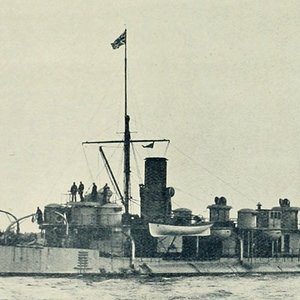Navigation
Install the app
How to install the app on iOS
Follow along with the video below to see how to install our site as a web app on your home screen.
Note: This feature may not be available in some browsers.
More options
You are using an out of date browser. It may not display this or other websites correctly.
You should upgrade or use an alternative browser.
You should upgrade or use an alternative browser.
Haruna named after Mount Haruna, was a warship of the Imperial Japanese Navy during World War I and World War II. Designed by the British naval engineer George Thurston, she was the fourth and last battlecruiser of the Kongō class, among the most heavily armed ships in any navy when built. Laid down in 1912 at the Kawasaki Shipyards in Kobe, Haruna was formally commissioned in 1915 on the same day as her sister ship, Kirishima. Haruna patrolled off the Chinese coast during World War I. During gunnery drills in 1920, an explosion destroyed one of her guns, damaged the gun turret, and killed seven men. During her life, Haruna underwent two major reconstructions. Beginning in 1926, the Imperial Japanese Navy rebuilt her as a battleship, strengthening her armor and improving her speed and power capabilities. In 1933, her superstructure was completely rebuilt, her speed was increased, and she was equipped with launch catapults for floatplanes. Now fast enough to accompany Japan's growing carrier fleet, Haruna was reclassified as a fast battleship. During the Second Sino-Japanese War, Haruna transported Imperial Japanese Army troops to mainland China before being redeployed to the Third Battleship Division in 1941. On the eve of the Japanese attack on Pearl Harbor, she sailed as part of the Southern Force in preparation for the Battle of Singapore.
Haruna fought in almost every major naval action of the Pacific Theater during World War II. She covered landings of Japanese forces in Malaya (in present-day Malaysia) and the Dutch East Indies (now Indonesia) in 1942 before engaging American forces at the Battle of Midway and during the Guadalcanal Campaign. Throughout 1943, Haruna primarily remained at Truk Lagoon (Micronesia), Kure Naval Base (near Hiroshima), Sasebo Naval Base (near Nagasaki), and Lingga (in present-day Malaysia), and deployed on several occasions in response to American carrier airstrikes on Japanese island bases. Haruna participated in the Battle of the Philippine Sea and the Battle of Leyte Gulf in 1944, engaging American vessels in the latter. In 1945, Haruna was transferred to Kure Naval Base, where she was sunk by aircraft of Task Force 38 on 28 July 1945.
Haruna fought in almost every major naval action of the Pacific Theater during World War II. She covered landings of Japanese forces in Malaya (in present-day Malaysia) and the Dutch East Indies (now Indonesia) in 1942 before engaging American forces at the Battle of Midway and during the Guadalcanal Campaign. Throughout 1943, Haruna primarily remained at Truk Lagoon (Micronesia), Kure Naval Base (near Hiroshima), Sasebo Naval Base (near Nagasaki), and Lingga (in present-day Malaysia), and deployed on several occasions in response to American carrier airstrikes on Japanese island bases. Haruna participated in the Battle of the Philippine Sea and the Battle of Leyte Gulf in 1944, engaging American vessels in the latter. In 1945, Haruna was transferred to Kure Naval Base, where she was sunk by aircraft of Task Force 38 on 28 July 1945.








